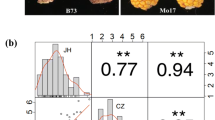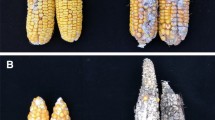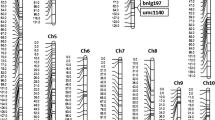Abstract
Gibberella ear rot (GER), caused by the fungal pathogen Fusarium graminearum, is becoming one of the most prominent pathogens responsible for ear rot in maize. In this study three F2 populations, F2-C, F2-D, and F2-J, and their corresponding F2:3 families, were constructed by crossing three highly GER-resistant inbred lines—Cheng351, Dan598, and JiV203—with the susceptible line ZW18. We used this cross for genetic analysis and QTL mapping of resistance to GER. Analysis of variance of GER in the three F2 populations revealed the presence of significant differences among genotypes and between locations. The broad-sense heritability (H2) of GER resistance was estimated to be 0.68, 0.63, and 0.64 in the three F2 populations, indicating that genetic factors play a key role in the development of phenotypic variation. Seventeen QTLs conferring resistance to GER were detected in the three F2 populations, among which the QTL qRger7.1, originating from the resistant parent Cheng351, explained 20.16–41.84% of the phenotypic variation. The physical support interval of qRger7.1 exhibited approximately 2 Mb overlap with that of qRger7.2, which was derived from the resistant parent Dan598, supporting the identification of potential “hotspots” of the target QTLs. QTLs derived from the resistant parents Dan598 and JiV203 accounted for 59.67–61.28% and 65.82–66.90%, respectively, of the phenotypic variation. The GER-resistant QTLs identified in this study are useful candidates for improving the resistance to GER in maize using molecular marker-assisted selection.






Similar content being viewed by others
References
Ali ML, Taylor JH, Jie L, Sun G, William M, Kasha KJ, Reid LM, Pauls KP (2005) Molecular mapping of QTLs for resistance to Gibberella ear rot, in corn, caused by Fusarium graminearum. Genome 48:521–533. https://doi.org/10.1139/g05-014
Basten CJ, Weir B, Zeng Z (1997) QTL cartographer: a reference manual and tutorial for QTL mapping. Department of Statistics, North Carolina State University, Raleigh
Bates D, Mächler M, Bolker B, Walker S (2015) Fitting linear mixed-effects models using lme4. J Stat Softw 67:133–199. https://doi.org/10.18637/jss.v067.i01
Brauner PC, Melchinger AE, Schrag TA, Utz HF, Schipprack W, Kessel B, Ouzunova M, Miedaner T (2017) Low validation rate of quantitative trait loci for Gibberella ear rot resistance in European maize. Theor Appl Genet 130:175–186. https://doi.org/10.1007/s00122-016-2802-3
Butrón A, Reid LM, Santiago R, Cao A, Malvar RA (2015) Inheritance of maize resistance to gibberella and fusarium ear rots and kernel contamination with deoxynivalenol and fumonisins. Plant Pathol 64:1053–1060. https://doi.org/10.1111/ppa.12351
Chungu C, Mather DE, Reid LM, Hamilton RI (1996) Inheritance of kernel resistance to Fusarium graminearum in maize. J Hered 87:382–385. https://doi.org/10.1093/oxfordjournals.jhered.a023019
Goertz A, Zuehlke S, Spiteller M, Steiner U, Dehne HW, Waalwijk C, de Vries I, Oerke EC (2010) Fusarium species and mycotoxin profiles on commercial maize hybrids in Germany. Eur J Plant Pathol 128:101–111. https://doi.org/10.1007/s10658-010-9634-9
Goswami RS, Kistler HC (2004) Heading for disaster: Fusarium graminearum on cereal crops. Mol Plant Pathol 5:515–525. https://doi.org/10.1111/j.1364-3703.2004.00252.x
Guo Z, Wang H, Tao J, Ren Y, Xu C, Wu K, Zou C, Zhang J, Xu Y (2019) Development of multiple SNP marker panels affordable to breeders through genotyping by target sequencing (GBTS) in maize. Mol Breed 39(3):37. https://doi.org/10.1007/s11032-019-0940-4
Knapp SJ, Stroup WW, Ross WM (1985) Exact confidence intervals for heritability on a progeny mean basis. Crop Sci 25:192–194. https://doi.org/10.2135/cropsci1985.0011183x002500010046x
Kosambi DD (1944) The estimation of map distances from recombination values. Ann Eugenics 12:172–175. https://doi.org/10.1111/j.1469-1809.1943.tb02321.x
Lincoln S, Daly M, Lander E (1992) Mapping genetic mapping with MAPMAKER/EXP3.0. Cambridge, Whitehead Institute Technical Report
Marin S, Ramos AJ, Cano-Sancho G, Sanchis V (2013) Mycotoxins: occurrence, toxicology, and exposure assessment. Food Chem Toxicol 60:218–237. https://doi.org/10.1016/j.fct.2013.07.047
Martin M, Miedaner T, Dhillon BS, Ufermann U, Kessel B, Ouzunova M, Schipprack W, Melchinger AE (2011) Colocalization of QTL for Gibberella ear rot resistance and low mycotoxin contamination in early european maize. Crop Sci 51:1935–1945. https://doi.org/10.2135/cropsci2010.11.0664
Martin M, Dhillon BS, Miedaner T, Melchinger AE (2012) Inheritance of resistance to Gibberella ear rot and deoxynivalenol contamination in five flint maize crosses. Plant Breed 131:28–32. https://doi.org/10.1111/j.1439-0523.2011.01908.x
Mesterházy Á, Lemmens M, Reid LM (2012) Breeding for resistance to ear rots caused by Fusarium spp. in maize-a review. Plant Breed 131:1–19. https://doi.org/10.1111/j.1439-0523.2011.01936.x
Munkvold GP (2003) Cultural and genetic approaches to managing mycotoxins in maize. Annu Rev Phytopathol 41:99–116
Reid LM, Nicol RW, Ouellet T, Savard M, Miller JD, Young JC, Stewart DW, Schaafsma AW (1999) Interaction of Fusarium graminearum and F. moniliforme in maize ears: disease progress, fungal biomass, and mycotoxin accumulation. Phytopathology 89:1028–1037. https://doi.org/10.1094/phyto.1999.89.11.1028
Sarinelli JM, Murphy JP, Tyagi P, Holland JB, Johnson JW, Mergoum M, Mason RE, Babar A, Harrison S, Sutton R, Griffey CA, Brown-Guedira G (2019) Training population selection and use of fixed effects to optimize genomic predictions in a historical USA winter wheat panel. Theor Appl Genet 132:1247–1261. https://doi.org/10.1007/s00122-019-03276-6
Van Ooijen JW (2006) Joinmap 4.0, software for the calculation of genetic linkage maps in experimental populations. Kyazma BV, Wageningen
Wu F (2007) Measuring the economic impacts of Fusarium toxins in animal feeds. Anim Feed Sci 137:363–374. https://doi.org/10.1016/j.anifeedsci.2007.06.010
Zeng ZB (1994) Precision mapping of quantitative trait loci. Genetics 136:1457–1468
Acknowledgments
We are grateful to Prof. Mingling Xu and his lab from China Agricultural University (Beijing, China) for kindly providing the Fusarium graminearum strain for use in this research.
Funding
This study was financially supported by the National Natural Science Foundation of China (NSFC, Grant No. 31701504).
Author information
Authors and Affiliations
Contributions
Yan Zhang and Dongyun Hao conceived and designed the project. Yan Zhang and Jing Wen wrote the paper with input from all authors. Yanqi Shen performed data analysis and disease evaluation. Yuexian Xing and Ziyu Wang prepared the F1, F2 generation and F2:3 families and conducted artificial inoculation. Siping Han, Shijie Li, and Chunming Yang performed other work, including planting in the field, pollination, data processing, and preparation of spore suspension.
Corresponding authors
Ethics declarations
Conflict of interest
The authors declare that they have no conflict of interest.
Ethics approval
Not applicable.
Consent to participate
Not applicable.
Consent for publication
Not applicable. This manuscript has not been published and is not under consideration for publication elsewhere. The manuscript has been seen and approved by all listed authors.
Code availability
Not applicable.
Additional information
Publisher’s note
Springer Nature remains neutral with regard to jurisdictional claims in published maps and institutional affiliations.
Electronic supplementary material
ESM 1
(DOC 1794 kb)
Rights and permissions
About this article
Cite this article
Wen, J., Shen, Y., Xing, Y. et al. QTL mapping of resistance to Gibberella ear rot in maize. Mol Breeding 40, 94 (2020). https://doi.org/10.1007/s11032-020-01173-1
Received:
Accepted:
Published:
DOI: https://doi.org/10.1007/s11032-020-01173-1




